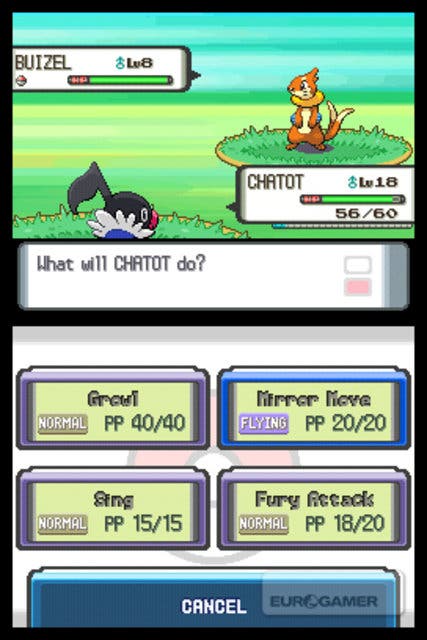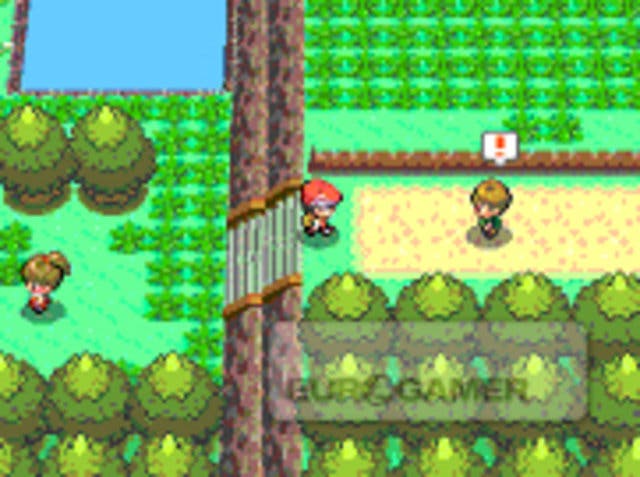Pok¨Śmon Diamond/Pearl
'Super Effective' as always.
In just ten short years since the franchise's introduction, the Pokémon series has enjoyed monumental success and now sits just behind Mario's many and varied outings as the second most lucrative gaming franchise of all time. But the basic facts don't really do justice to the phenomenal sales of the monster battling saga. Indeed, if you factor in the fact that Mario has had the benefit of a ten-year head start, as well as the fact that the NES, SNES and N64 all featured huge-selling Mario hardware bundles, things start to look a little more impressive. But of course, 'things that are popular' and 'things that are good' aren't always the same thing. Just look at Oasis and Coldplay. Anyone who has played one of the true Pokémon adventures, though, will most likely vouch for the quality - and with so many improvements squeezed in between oodles of fuzzy familiarity for this DS debut, it looks like 160-odd million sales might be justified for this market-leading IP.
Over a hundred new monsters join the party for this new generation of acceptable cock-fighting, ranging from the straight lame to the wondrously creative. The fact that such a large portion of the newly introduced creature are either evolutions or baby versions of existing monsters has the unfortunate side-effect of making Game Freak look a little short on ideas at times. Still, new stages of evolution for the likes of Togetic, Rhydon and the magnificent Lickitung, among others, should mean that entire families of Pokémon that have been ignored since their respective debuts finally get some use in competitive play. Diamond and Pearl make sure to tick all the boxes their predecessors have laid out for them, showcasing a great trio of starters as always, a not-so-great trio of annoyingly elusive legendary monsters and a couple of Pokémon that simply can't be obtained until Nintendo decides you can have them. But it's not so much the regurgitated and formulaic elements that'll make you sit up and take notice of these new adventures, rather the brand new stuff that Diamond and Pearl bring to the table.

Making full use of the DS' Wi-Fi options, the new Pokémon duo allow friends both close and distant to battle or trade at their leisure. With this potential for global challenges absent from every other Pokémon game thus far, fans that had resorted to battling over PC programs or websites can finally take on the world legitimately. And it isn't just about facing off against rivals online either (although, incidentally, there's no option for battling random opponents, so you'll need to get your Friend Code out there if you're planning on showing your team off). The Global Trade Centre allows for trade requests to be posted on a worldwide bulletin board, where you can either search for what other Trainers have made available or throw one of your own monsters up there, specifying exactly what you want in return for your former friend. But don't assume that this new feature will make finishing your Pokédex any easier. Since you're only able to search the network for Pokémon that you've seen, you're unlikely to be scoring yourself a Mew or a Bulbasaur from the GTC any time soon.

But if it's old monsters you want, you don't have to look much farther than the small cartridge which should, if you have any sense, already be firmly lodged inside your DS. After the mess that was made with regards to the unavailability of older monsters in Ruby and Sapphire, Nintendo seems to have wised up to the fact that perhaps forcing budding Trainers to shell out for GameCube games and remakes just to tick a few boxes was a slightly cynical move. In Diamond and Pearl, you'll find the largest number of obtainable monsters in any Pokémon title to date, encompassing all two hundred entries in the Sinnoh Pokédex, naturally, as well as the vast majority of older creatures as well. In fact, the only Pokémon you won't be able to find in this new game region are the starting monsters (such as Charmander or Totodile) and legendaries (Mewtwo, Rayquaza and the like) from previous generations. Any Pokémon buff will most likely already have most of these on a GBA cartridge somewhere though, which is good because the Pal Park feature will allow these one-shot monsters to be transferred into Diamond or Pearl as and when you want. Only six a day can leap the generation gap in this way, presumably to avoid abuse of the function, but with so many familiar faces now resident to the Sinnoh area, only one-offs, personal favourites and elusive Pokémon need be transferred.

Whatever anyone tells you, you're never too old to enjoy Pokémon. Anyone who says otherwise is an idiot, a liar or possibly both. No, the immense depth, inescapable charms and boundless personalisation found here is enough to put most other commercial releases to shame, with the new battle mechanics making Diamond and Pearl even more covertly complex than the series has previously been. Anyone can have fun with a Pokémon game - be it an infant barely old enough to read the text or a middle-aged suit slacking off work to browse the web for IV calculators and breeding guides - and this fact alone is enough grounds for us to go with the buying public and heartily endorse this continuation of the legacy. Everything on show is bigger and better than a handheld release has any right to be and this new era of Pokémon is ushered in by a pair of the most adept, cavernous and life-absorbing RPGs on the market today. In fact, the amount of time we've lost to this game already (not to mention the series in general) is probably too staggering for the internet to take. We actually broke the in-game clock in Pokémon Gold by maxing out the play-time and judging by the way things are going, that instance invariably won't be the last of its kind. Allow yourself to succumb to its ample charms and you'll never look back. Or at anything that isn't a DS screen, for that matter. Not for some time, anyway. After all, all those cuddly little critters... they're hardly going to catch and raise themselves now, are they?
